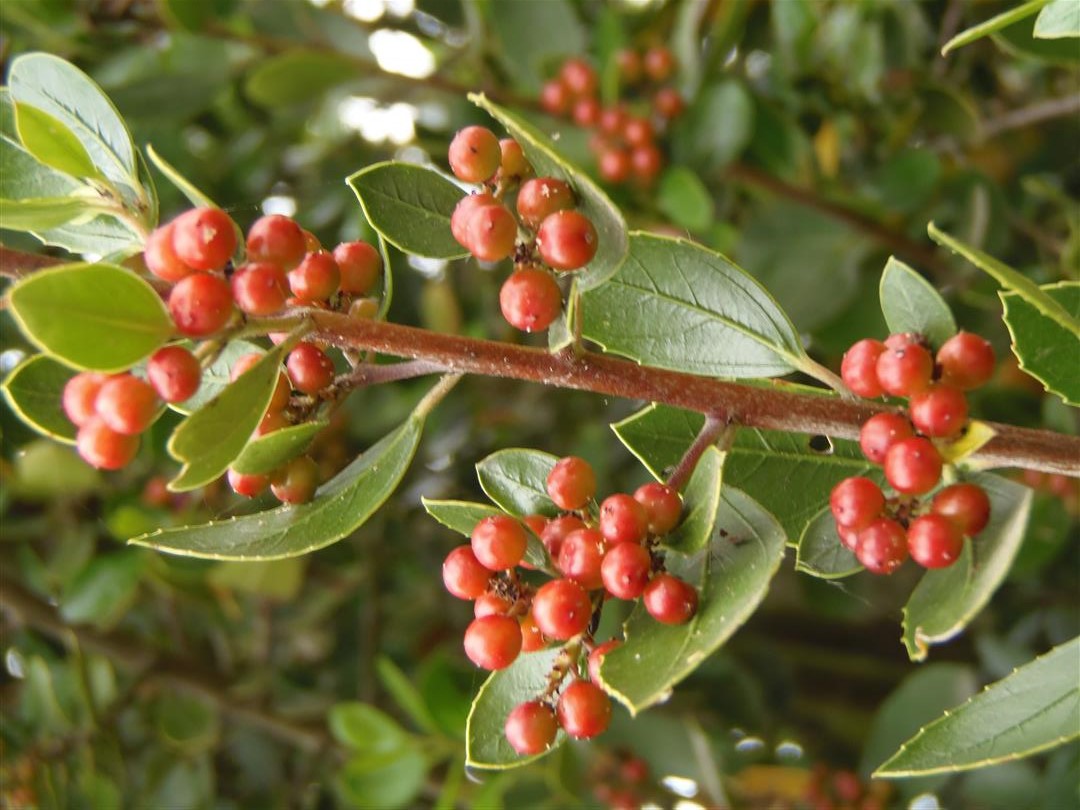Created on: Tuesday, Jan 26th, 2016
Reviewed by Joe DiTomaso (UC Davis WRIC, not named in Issues), Ron Vanderhoff (CA Native Plant Society- Orange Co. Chapter, rvanderhoff@sbcglobal.net), and Irina Irvine (Santa Monica Mtns Nat’l Recreation Area, irina_irvine@nps.gov).
Ron Vanderhoff comment in general: "Rhamnus alaternus is a dioecious plant. It is also a fairly common (and growing in popularity) horticultural plant. However, this situation causes some interesting considerations.
Within the horticultural industry this species is almost solely represented by the selection Rhamnus alaternus 'John Edwards'. This selection originated at John Edwards Nursery in East Palo Alto, California. It was introduced in or before 1962 by the Saratoga Horticultural Foundation of California. This selection is the only taxa I have every seen for sale in California (I am the general manager at California's largest and busiest retail garden center). This selection is reported to be a male, fruitless clone. I have never seen seed set on any of these selections over the past 15 years or so, including many rather large and old examples.
Nonetheless, one of the most significant infestations of this species is right here in Newport Beach at Upper Newport Bay. The species was first reported here in 1988, which appears to be the first record for CA. Since that time it has spread assertively in this area and is now a significant management concern. The plants at this Newport Beach infestation include both male and female examples and not the 'John Edwards' selection. This population is spreading rather agressively via abundant seed production.
So . . . . . many of these PRE questions become complicated due to the dioecious quality of this plant and by the main (only?) plant in commerce being functionally sterile. I suspect that the PRE scoring should be based upon worse-case (male and female plants), which is the manner in which I performed my review. Nonetheless, perhaps the male-clone issue should be a consideration in any communications or recommendations re the species. I know communication and implementation discussions may be outside of the PRE score, but wanted to bring it as a topic."
The following websites were referenced for this screen: http://www.tropicos.org/Name/27500971 https://npgsweb.ars-grin.gov/gringlobal/taxonomydetail.aspx?31012 http://www.smgrowers.com/products/plants/plantdisplay.asp?strSearchText=... http://herbaria4.herb.berkeley.edu/eflora_display.php?tid=81104 http://davesgarden.com/guides/pf/go/1733/ http://www.calflora.org/cgi-bin/species_query.cgi?where-calrecnum=11985 http://plantlust.com/plants/rhamnus-alaternus-argenteovariegata/ http://www.cal-ipc.org/symposia/archive/pdf/2008/6Brusati.pdf http://www.sfnps.org/download_product/4420/0 http://www.calfloranursery.com/our-plants-all-list-view/r http://www.calfloranursery.com/plants/rhamnus-alaternus-variegatus http://www.arthurleej.com/p-o-m-Feb07.html http://www.lagunahillsnursery.com/gary-hedges_screens.htm http://www.mercurynews.com/home-garden/ci_26033293/creating-drought-tole... http://plants.usda.gov/core/profile?symbol=RHAL12 http://keyserver.lucidcentral.org/weeds/data/03030800-0b07-490a-8d04-060... http://www.issg.org/database/species/ecology.asp?si=893&fr=1&sts=sss&lan... http://plantnet.rbgsyd.nsw.gov.au/cgi-bin/NSWfl.pl?page=nswfl&lvl=sp&nam... https://en.wikipedia.org/wiki/Rhamnus_alaternus http://www.hear.org/pier/species/rhamnus_alaternus.htm http://www.rnzih.org.nz/pages/rhamnusalaternus.htm http://www.hear.org/gcw/species/rhamnus_alaternus/ http://www.weedbusters.co.nz/weed-information/rhamnus-alaternus/59/ http://www.discoverlife.org/mp/20q?search=Rhamnus+alaternus http://www.cal-ipc.org/symposia/archive/pdf/2010/6Moverley.pdf http://www.thebookshelf.auckland.ac.nz/docs/Tane/Tane-36/5%20Rhamnus%20a... http://www.doc.govt.nz/Documents/science-and-technical/SFC209.pdf http://www.inspection.gc.ca/plants/plant-pests-invasive-species/invasive... http://pir.sa.gov.au/__data/assets/pdf_file/0020/234605/Italian_buckthor... http://link.springer.com/article/10.2478%2Fs11535-014-0291-4 http://www.jstor.org/stable/pdf/20146871.pdf?acceptTC=true http://www.biosecurity.govt.nz/files/pests/plants/nppa/nppa-accord-manua... http://www.diablofiresafe.org/tolerance.html
- < 13 : accept (low risk of invasiveness)
- 13 - 15 : evaluate further
- > 15 : reject (high risk of invasiveness)

